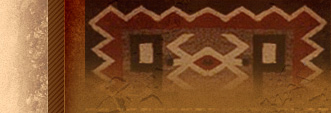 |
 |
| |
Emergence
|
|
| |
"Emergence" describes a special phenomenon by which something entirely new arises from a large gathering of things or ideas. The most important thing to understand about it is that this new thing can not be reduced to the sum of its parts; it has unique properties that do not exist in any of the elements whose convergence gave rise to it.
An example of emergence is the image seen in a woven European tapestry; the colored threads that make up the image do not, themselves, contain the picture or any part of the picture within them. The image of a hunt or a procession only emerges when all the component threads are gathered in a particular way. The rug at the top of this web page is a Diné (Navajo) example of the same phenomenon. The two black rectangles represent two of the sacred holy mountains that delineate the Diné homeland. In this case, "reading the image" doesn't depend only on eyesight for comprehension; more than mere threads must converge for the full image to emerge.
Emergence always takes place in conjunction with, and as a consequence of, the convergence of many dissimilar things. A similar paradox is seen in science, in the spontaneous emergence of order from sufficient complexity. When we say diversity produces power in community learning environments, and that understanding flows from many sources, we are talking about tenets for group learning that foster the emergence of a new concept of relationship between humans and the earth.
|
|
|
|
|
|
 |
|
|

